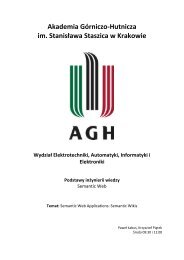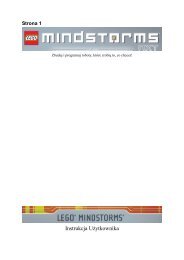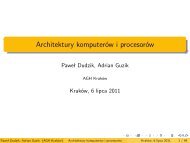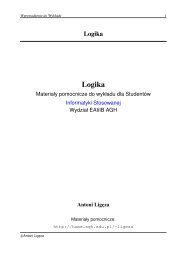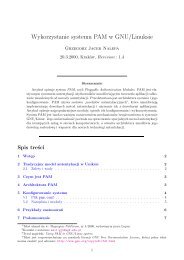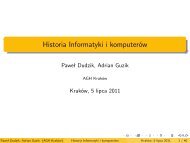An Evaluation of Knowledge Base Systems for Large OWL Datasets
An Evaluation of Knowledge Base Systems for Large OWL Datasets
An Evaluation of Knowledge Base Systems for Large OWL Datasets
You also want an ePaper? Increase the reach of your titles
YUMPU automatically turns print PDFs into web optimized ePapers that Google loves.
such as the depth and width <strong>of</strong> class hierarchies 6 , and the way the classes and properties<br />
chain together in the query.<br />
To express the benchmark queries, we use a language in which a query is written as<br />
a conjunction <strong>of</strong> atoms. The language syntactically resembles KIF [12] but has less<br />
expressivity. We did not select from existing query language <strong>for</strong> RDF/<strong>OWL</strong> such as<br />
RQL [23], RDQL [29] or TRIPLE [30] since none <strong>of</strong> them has proven dominant. The<br />
simple language we use provides us with minimal while sufficient expressivity (i.e.,<br />
existentially quantified conjunction <strong>of</strong> first-order logic atoms) and could be easily<br />
translated into any <strong>of</strong> the RDF/<strong>OWL</strong> query languages.<br />
2.4 Per<strong>for</strong>mance Metrics<br />
In addition, LUBM consists <strong>of</strong> a set <strong>of</strong> per<strong>for</strong>mance metrics including load time, repository<br />
size, query response time, query completeness and soundness, and a combined<br />
metric <strong>for</strong> the query per<strong>for</strong>mance. Among these metrics: the first three are standard database<br />
benchmarking metrics - query response time was introduced in the Wisconsin<br />
benchmark, and load time and repository size have been commonly used in other database<br />
benchmarks, e.g., the OO1 benchmark [8]; query completeness and soundness are new<br />
metrics we developed <strong>for</strong> the benchmark. We address these metrics in turn below.<br />
Load Time<br />
In a LUBM dataset, every university contains 15 to 25 departments, each described by<br />
a separate <strong>OWL</strong> file. These files are loaded to the target system in an incremental fashion.<br />
We measure the load time as the stand alone elapsed time <strong>for</strong> storing the specified<br />
dataset to the system. This also counts the time spent in any processing <strong>of</strong> the ontology and<br />
source files, such as parsing and reasoning.<br />
Repository Size<br />
Repository size is the consequent size <strong>of</strong> the repository after loading the specified benchmark<br />
data into the system. We only measure the consequent database sizes <strong>for</strong> the database<br />
based systems. We do not measure the occupied memory sizes <strong>for</strong> the main memory-based<br />
systems because it is difficult to accurately calculate them. However, since<br />
we evaluate all systems on a plat<strong>for</strong>m with a fixed memory size, the largest dataset that<br />
can be handled by a system provides an indication <strong>of</strong> its memory efficiency.<br />
Query Response Time<br />
Query response time is measured based on the process used in database benchmarks.<br />
To account <strong>for</strong> caching, each query is executed <strong>for</strong> ten times consecutively and the average<br />
time is computed. Specifically, the benchmark measures the query response time<br />
as the following:<br />
For each target repository:<br />
For each test query:<br />
6<br />
We define a class hierarchy as deep if its depth is greater than 3, and as wide if its average<br />
branching factor is greater than 3.




